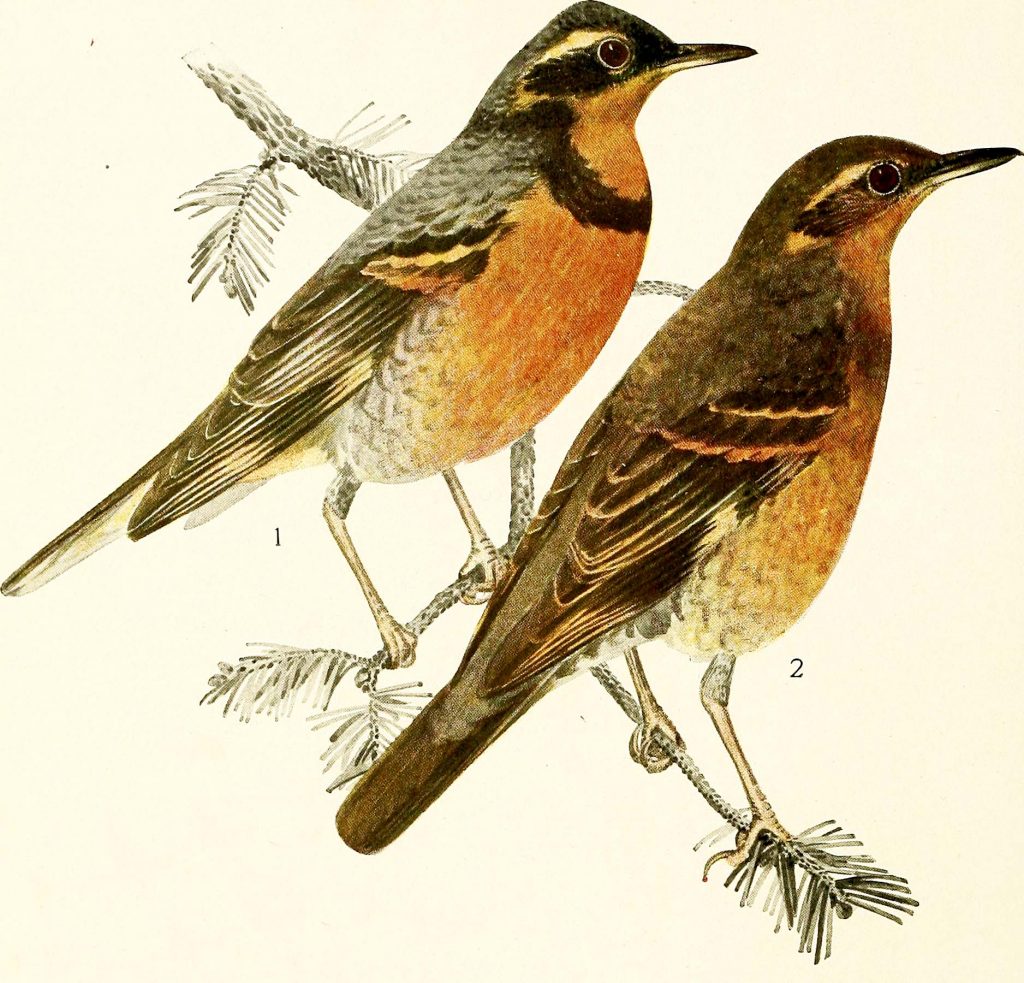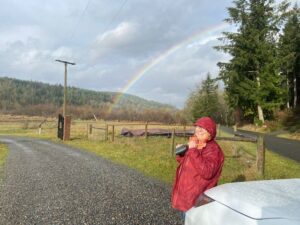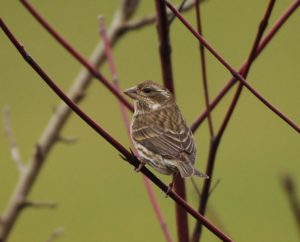Varied Thrush – Ixoreus naevius, Family: Turdidae, Order: Passeriformes

by Sharon Moore – The Varied Thrushes have returned! With fall’s arrival we’ve recently welcomed these lovely woodland songbirds back to the thickets on our properties and in the forest undergrowth. Listen closely and you may hear the male Varied Thrush’s unusual call. Vocalizing year round, he produces a prolonged eerie, shrill whistle in a minor note, repeating that note at different pitches after long pauses.
At nine inches long, the Varied Thrush is easy to identify amidst the juncos, sparrows and spotted towhees with which it feeds. Its stocky body, long legs, round head, straight bill and short tail remind us of a robin but its bold coloration distinguishes it as the orange and gray-black colors punctuate the dark green forest understory where it generally shelters. The male sports a gray-blue back, burnt orange breast, and darkgray half-moon on the breast, mixed orange and gray wing bars and an orange line over the eye. The female replicates the physical characteristics of the male though she is lighter colored and browner than the male with a faint gray breast band rather than the darker band of the male.
Varied Thrushes generally arrive in our region in October from their summer breeding grounds in the Yukon and Alaska. Over millennia this species has habituated to the temperate northwestern coastal forests that are dominated by conifers – the oldest and largest trees in the world, among them the Douglas fir, Western Hemlock and Sitka Spruce. Should our winter become too cold and snowy, these birds may leave us, migrating as far as southern California and northern Baja. Though the reasons for this fragmented migration are not entirely understood, it’s likely that the species is searching for more abundant food sources.
As general ground feeders, these birds often winter locally in loose flocks, staying hidden in the undergrowth, pecking at the ground, tossing leaves as they go, searching for arthropods and worms during the dark, wet months as well as through the spring breeding season. During migration and while they’re here in winter they’re also partial to native fruits. Occasionally they arrive at our feeders searching for hulled sunflower seeds, suet, fruit and mealworms.
Historically, Varied Thrushes bred in lowland forests; however, there is recent evidence that, due to forest fragmentation, they are now reproducing primarily in the mountains where conifer forests are denser. Once they choose an appropriate tree in which to raise a family, they construct an open-cup nest of twigs, grasses, mosses, bark strips, pine needles and weeds. Nests are built in the center of the male’s territory comprising from one to five or six square acres. Once in breeding mode the male will vigorously defend his territory with body posturing, raising crown feathers and wing and tail flicking. If the threat is intense, he won’t fail to aggressively chase the potential rival. The female usually lays from 3 to 5 eggs and most pairs are thought to produce two broods per year. Both parents feed the nestlings. Unfortunately, even though the adults take great care in positioning the nest, the open-cup design leaves the chicks exposed to many predators including jays, crows, weasels and red squirrels. The average nestling mortality rate remains unknown.
Even though the Varied Thrush population is currently regarded as relatively stable, the increasing threat of global warming suggests the longer-term prognosis for this species’ survival is bleak. In fact, all western forest-dwelling and arboreal forest birds are intensely vulnerable to the temperature increases that are already causing climate disruption. A recently published Audubon study predicts that should summer temperatures increase by 1.5 degrees Celsius (2.7 degrees Fahrenheit), the Varied Thrush will lose 34% of its summer habitat and 19% of its winter habitat. If the summer temperature rises by 2 degrees Celsius (3.6 degrees Fahrenheit), Varied Thrushes are projected to lose 44 % or more of their suitable summer habitat and 21% of their winter range. At this point the bird would be struggling to find adequate food and habitat for raising offspring. Should temperatures rise any higher, the Varied Thrush and most other western forest-dwelling species will be in extreme danger of extinction.







